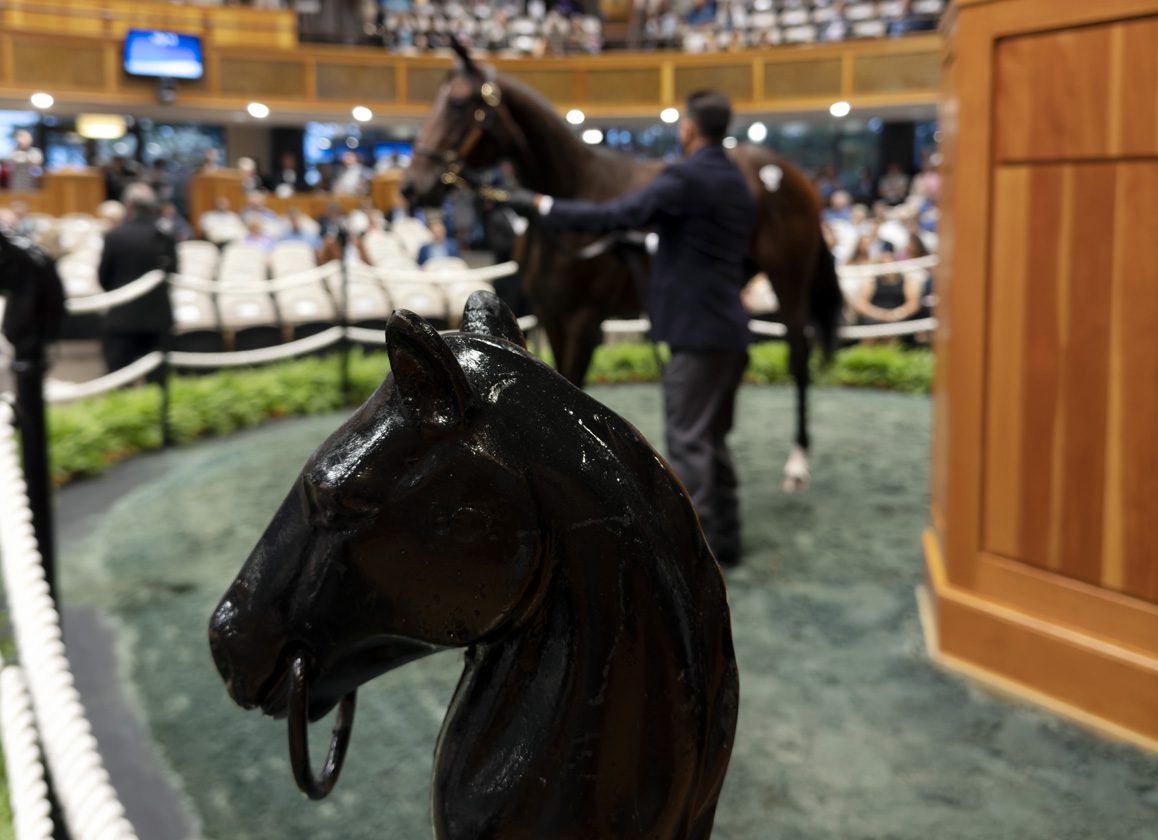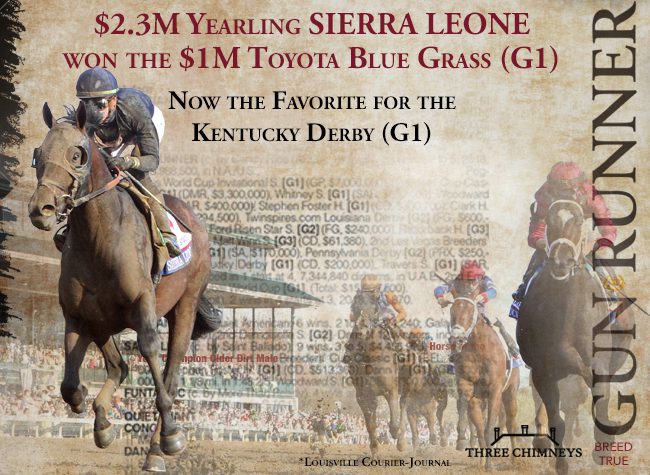By Chris McGrath
If a tree falls in the forest and there's nobody there to hear it, does it still make a sound? We'll leave their old teaser to the philosophers, to debate whether noise still qualifies as “sound” if it doesn't reach anyone's ear. But for a long time now our own industry has been puzzling over a still more perplexing version: if a tree falls in the forest, or indeed if a war breaks out in Europe, or a pandemic sweeps the planet, or central banks have to douse the fires of inflation…. How does anyone ever know, if they're all at a horse sale?
Our trade has in recent years appeared mysteriously impervious to many of the economic dramas afflicting the outside world. In 2023, however, many keynote auctions have experienced what felt like an inevitable and possibly overdue moderation of the tempo. Nothing too dramatic, in the main: the kind of thing that might be described as a “correction,” often measuring up more than respectably to what had seemed extremely robust figures in 2021, prior to a notably giddy spike at the elite auctions last year. But those trends are internal: they are measured, year to year, in the same ring and in the same currency. Now that we can more or less close out the data on the 2023 yearling market, however, we're in a position to take a step back and assess its overall performance in the kind of transnational terms that match the perspective of its principal investors.
And, with only a couple of minor European sales still to be entered on the ledger, it turns out that the aggregate value of the yearling market either side of the Atlantic in 2023 has almost precisely matched even the historic landmark of last year. Then, for the first time, we were able to acclaim “Billion Dollar Babies.” This time round, the headline figure has inched up 0.3 percent from $1,001,529,828 to $1,004,465,043.
| region | year | catalogued | Out | % out to cat | ring | sold | % sold to out | gross | average |
| All | 2023 | 14649 | 1918 | 13.09 | 12731 | 10268 | 80.65 | $1,004,465,043 | $ 97,825 |
| All | 2022 | 14499 | 1825 | 12.58 | 12674 | 10559 | 83.31 | $ 1,001,529,828 | $ 94,851 |
| All | 2021 | 13546 | 1769 | 13.05 | 11777 | 9924 | 84.26 | $ 937,533,161 | $ 94,471 |
| All | 2020 | 13876 | 2336 | 16.83 | 11540 | 8876 | 76.91 | $ 687,432,621 | $ 77,448 |
| All | 2019 | 16055 | 2173 | 13.53 | 13882 | 10649 | 76.71 | $ 905,622,360 | $ 85,043 |
When you think of the huge spectrum of yearlings to come under the hammer from each crop, this virtual parity feels almost freakish, especially when so closely matched by the numbers entering the ring: 12,731 this year, compared with 12,674 in 2022. One of the few conspicuous wedges between the two years is a slippage in the clearance rate, from 83.3 percent to 80.7, translating into a 2.75 percent drop in overall sales to 10,268 from 10,559. Sure enough, then, the average cost of every yearling in the combined transatlantic market has actually advanced 3.1 percent to a new high of $97,825 from $94,851.
That headline positive duly contains a mild negative, in that the average achieved from essentially unchanged turnover goes up because there have been more RNAs. But the bottom line is that those that did change hands made more money than ever.
Nonetheless there are a couple of caveats to that statement. The most important is that the European element must always be assessed through the prism of fluctuating exchange rates. Last year, for instance, the dollar value of a soaring internal market in Europe actually weighed in 2.4 percent lighter than in 2021. This time round, European trade converted to $404,163,529, up 3.3 percent from $391,241,817, on the face of it a wholesome contrast with a marginal slip (1.6 percent) in the American gross from $610,288,011 to $600,301,513.
| region | year | catalogued | Out | % out to cat | ring | sold | % sold to out | gross | average |
| EU | 2023 | 6019 | 547 | 9.08 | 5472 | 4556 | 83.26 | $404,163,529 | $ 88,710 |
| EU | 2022 | 6295 | 589 | 9.35 | 5706 | 4845 | 84.91 | $ 391,241,817 | $ 80,752 |
| EU | 2021 | 5730 | 512 | 8.93 | 5218 | 4480 | 85.85 | $400,981,400 | $ 89,505 |
| EU | 2020 | 6219 | 765 | 12.3 | 5454 | 4357 | 79.88 | $ 328,852,326 | $ 75,477 |
| EU | 2019 | 6864 | 620 | 9.03 | 6244 | 4982 | 79.78 | $ 391,396,347 | $ 78,562 |
But much of that gain in European trade reflects the anaemic condition of sterling last year. During Book I at Tattersalls it traded at $1.13, and there had been little change by the time the global data was reported for a similar examination this time last year. By the start of the year, sterling had hauled its way up a few rungs to $1.21 and–following a mild midsummer swell–that's pretty well where it remains today. So while an American buying a Book I yearling this year might regard the extra cost of a “guinea” this time as no big deal, the difference was comfortably more than the increase in the dollar value of the European yearling market.
We're a still a long way from pre-Brexit values, however. In October 2015, sterling at $1.52 meant that the Book I average converted to almost exactly $355,000. This time round, when the local value of a Book I yearling was 9.7 percent higher than 2015, the dollar value remained 12.7 percent lower. Domestic vendors should not deceive themselves, then, that it is only the caliber of their stock that might have been tempting American investors since the great Brexit tantrum.
Of course, if you're trading within that market none of this will matter. A domestic pinhooker, or a breeder who pays a local stallion fee, will be paying electricity bills and wages in the same currency. Within that trading environment, in Europe, a few factors together conspired to take some of the heat out of the market compared with 2022: just one of the final crop of yearlings by Galileo (Ire) surfaced in Book I, for instance, even as his premier son Frankel (GB) becomes increasingly the resort of top breed-to-race programs. (And then there was the fact that one of the biggest contributors to turnover in 2023 never actually paid up!)
As for the American market, perhaps the key indicator is the decline in clearance to 78.7 percent sold, from those entering the ring, down from 82 percent last year and 83 percent in 2021. We've already noted the impact on the overall figures, the European rate having held up a good deal better at 83.3 percent, after registering frantic demand (84.9 and 85.9 percent) over the two previous years. As a result, at $105,095, the average North American yearling transaction in 2023 fell only just short of last year's breakthrough figure, when the six-figure barrier was breached for the first time at $106,808. In other words, people appear to have been a little “pickier” in their shopping while being prepared to go harder at their final shortlist. A little tougher to sell, then; but a little tougher to get that hammer to fall, too. But don't forget that a clearance rate touching 79 percent is still way better than 74 percent in the year before the pandemic.
| region | year | catalogued | Out | % out to cat | ring | sold | % sold to out | gross | average |
| NA | 2023 | 8630 | 1371 | 15.88 | 7259 | 5712 | 78.68 | $600,301,513 | $ 105,095 |
| NA | 2022 | 8204 | 1236 | 15.06 | 6968 | 5714 | 82 | $ 610,288,011 | $106,806 |
| NA | 2021 | 7816 | 1257 | 16.08 | 6559 | 5444 | 83 | $ 536,551,762 | $ 98,558 |
| NA | 2020 | 7657 | 1571 | 20.51 | 6086 | 4519 | 74.25 | $ 358,580,295 | $ 79,349 |
| NA | 2019 | 9191 | 1553 | 16.89 | 7638 | 5667 | 74.19 | $ 514,226,013 | $ 90,740 |
One way or another, the market plainly remains robust. A mild loss of momentum in some indices feels somewhat overdue, if anything, a prolonged bull run having suggested bloodstock to be immune even to the most alarming economic and geopolitical tremors. But it may be that those whose affluence has been consolidated even through times of plague and war are not quite so indifferent to an altered fiscal landscape.
It was always contentious that the cash doping of panicked economies persisted so long after the banking crisis, but for a while now we've found ourselves back in a forgotten world of high interest rates. And central banks still aren't getting enough patches of blue sky to put away the umbrella. Meanwhile the S&P 500 is heading towards its third negative month in a row, which hasn't happened since the start of the pandemic in 2020. There's new instability in the Middle East, compounding the ongoing crisis in Ukraine, and a turbulent election year ahead. Those are some of the trees falling in the forest.
Our own world persists in its insularity, albeit without a great deal of coherence. Demand for racehorses can only be described as healthy, if the transatlantic yearling market can maintain the $1 billion breakthrough of last year. But supply continues to diminish, with a declining foal crop ever less eligible to service the betting windows and so, ultimately, purses. In the meantime, we have slot boomtowns even as storied venues are closing; extremes that make our sport's very survival bitterly contentious, including within our own community. Above all, we persist in placing the cart of commercial breeding in front of the horse itself. (We've just come within a couple of shifts of a totally unproven sire covering 300 mares!)
There remain many things we can be positive about, as we hope to be reminded at our principal showcase this weekend. But we can't take this resilience of investment, remarkable as it is, for granted. As and when it dries up, we need to be ready with a resilience of our own: with a breed, and a sport, equipped to last.
Not a subscriber? Click here to sign up for the daily PDF or alerts.






